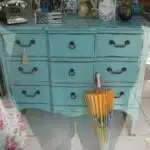Welcome, craft enthusiasts! As we approach the festive season, it is an excellent opportunity to get creative with holiday ornaments. Painting ornaments is a fun and engaging way of adding a personal touch to your decorations. However, with so many painting techniques available, it can be challenging to choose the right method. In this article, we will explore two different methods for painting ornaments that are guaranteed to impress your guests.
The first method involves using acrylic paints and brushes to create intricate designs on round glass ornaments. This technique allows you to experiment with various colors and brush strokes, resulting in unique patterns on each ornament. The second method utilizes alcohol inks and rubbing alcohol to create abstract designs on ceramic or plastic ornaments. This process is perfect for those looking to add a modern twist to their decorations while also being quick and easy. By mastering these two techniques, you’ll have the skills needed to make beautiful hand-painted ornaments that will become cherished family heirlooms for years to come. So let’s get started!
Gathering Supplies
According to a recent survey, more than 70% of people enjoy making their own holiday decorations. If you’re one of them, you’ll need to gather some supplies before you get started. Here’s a checklist of what you’ll need for painting ornaments:
- Acrylic paint in various colors
- Small paintbrushes
- Ornaments (either plain or pre-made white ceramic ones)
- Water and a container for rinsing brushes
- Paper towels or cloth rags for wiping brushes
- Optional: glitter, ribbon, or other embellishments
Make sure your workspace is set up before starting. You’ll want a clean, well-lit area where you can comfortably sit and work without any distractions. Cover your work surface with newspaper or a plastic tablecloth to protect it from spills and splatters.
Preparing your workspace is just the first step towards creating beautiful painted ornaments. With the right supplies and setup, you’ll be on your way to making unique and personalized decorations that will impress everyone who sees them. So let’s get started!
Preparing Your Workspace
Organizing your workspace is essential when it comes to painting ornaments. You want to make sure that you have enough space to work comfortably and efficiently. Start by clearing the area of any unnecessary items, such as clutter or distractions. This will help you focus on the task at hand and prevent any accidents from occurring.
Next, consider setting up lighting that is conducive to painting. Ideally, you want natural light or a bright lamp that illuminates your workspace evenly. This will help you see the details of your ornament clearly and prevent eye strain or headaches from poor lighting. Additionally, having good lighting will ensure that you do not miss any spots while painting.
Once you have organized your workspace and set up proper lighting, it’s time to move onto the actual painting process. In the next section, we will discuss method 1: acrylic paints and brushes. With this method, you’ll learn how to paint your ornaments with precision using high-quality materials that are designed specifically for this purpose. Whether you’re a beginner or an experienced painter, this method is sure to produce beautiful results that will impress everyone who sees them.
Method 1: Acrylic Paints And Brushes
When it comes to painting ornaments, the use of acrylic paints and brushes is a popular option. Acrylic paints are vibrant, quick-drying, and easy to work with. To achieve a professional-looking finish, it’s important to master blending techniques and color mixing tips.
Blending techniques involve gradually transitioning from one color to another. This can be achieved through methods such as wet-on-wet painting or dry brushing. Wet-on-wet involves applying paint on top of a still-wet layer to create a smooth transition between colors. Dry brushing involves using a mostly-dry brush to lightly apply paint over an existing layer for a more textured effect.
Color mixing tips are also crucial for creating unique shades and tones on your ornaments. For example, adding white to a color will lighten it while adding black will darken it. Mixing complementary colors (colors opposite each other on the color wheel) will create brown or gray tones. Experimenting with different ratios and combinations can lead to endless possibilities.
By mastering blending techniques and color mixing tips when using acrylic paints and brushes, you can create stunning designs for your ornaments. The next step is choosing your colors, which we’ll explore in the following section.
Choosing Your Colors
When it comes to painting ornaments, choosing the right colors is crucial. Whether you’re a beginner or an experienced artist, your color palette can make all the difference in the final result. There are two main mixing techniques you can use: subtractive and additive.
Subtractive mixing involves starting with a base color and gradually adding other colors to create variations. This method is useful when working with darker colors or when trying to achieve a specific hue. Additive mixing, on the other hand, involves starting with a white base and gradually adding colors until you reach the desired shade. This is more commonly used when working with lighter hues.
To choose the right colors for your ornaments, consider your overall theme or aesthetic. Are you going for a traditional red and green look? Or perhaps something more modern with pastels? Take inspiration from the world around you – nature, fashion, and art can all provide great ideas for color palettes.
Here are some tips to keep in mind:
- Stick to 2-3 main colors for a cohesive look
- Use complementary colors (such as blue and orange) for contrast
- Consider using metallics (like gold or silver) for added sparkle
- Don’t be afraid to experiment with different shades and tones within your chosen palette
Now that you have some ideas for your color palette, it’s time to move onto applying the base coat.
Applying Base Coat
As you apply the base coat on your ornaments, you will be laying the foundation for your final design. This is a crucial step in achieving a polished and professional look for your decorative pieces. One technique to consider is blending colors to create unique and interesting combinations.
Blending techniques allow you to combine two or more colors to create a gradient effect. This can be achieved by applying one color at a time, blending them together as you go. Alternatively, you can mix different shades of paint on a palette before applying them to the ornament. The key is to blend the colors seamlessly, so there are no harsh lines or noticeable transitions between them.
When choosing color combinations for your ornaments, consider the overall theme or style that you want to achieve. For example, if you want a classic and elegant look, try pairing metallic gold with black or white. If you prefer a more playful and whimsical style, experiment with bright and bold colors like pink and turquoise. The possibilities are endless, so have fun exploring different color palettes!
As you continue with your painting project, adding designs and patterns will bring your ornaments to life. But first, make sure that your base coat is smooth and even before moving on to the next step. With blending techniques and creative color combinations under your belt, you’re ready to take your ornaments to the next level!
Adding Designs And Patterns
- Stenciling is a method of adding designs and patterns to a surface by placing a template on the surface and painting or inking through the openings in the template.
- Stamping is a method of adding designs and patterns to a surface by pressing a stamp into ink or paint and then pressing the stamp onto the surface.
- Freehand painting is a method of adding designs and patterns to a surface by using a brush or other painting utensil to manually draw the design.
- When stenciling, it is important to use a light touch to avoid smearing the paint or ink.
- When stamping, it is important to use the right amount of ink or paint and to press firmly to ensure a clear impression.
- When freehand painting, it is important to use a steady hand and to practice the pattern before attempting it on the surface.
Stenciling
As an artist or crafter, there’s something special about creating personalized ornaments that can bring joy to many people. One way to add designs and patterns to ornaments is through stenciling technique. Stenciling is a great way to create perfect and symmetrical designs without the need for freehand drawing.
When it comes to stenciling on ornaments, it’s important to choose the right type of stencil that will work best with the material of your ornament. For instance, if you’re working with a curved surface like a round glass ornament, consider using flexible stencils made from mylar or plastic. These stencils can easily conform to the shape of the ornament without leaving any unwanted gaps or spaces.
To get started with stenciling on ornaments, first place your stencil onto the ornament and secure it in place with tape. Then, use a stencil brush or sponge dabber to apply paint over the stencil openings. Be sure not to overload your brush or sponge as this may cause paint bleed under the edges of the stencil. Once done, carefully remove the stencil from your ornament and let it dry completely before adding any additional layers or embellishments.
Overall, stenciling technique offers a simple yet effective way to add designs and patterns on ornaments. By choosing the best stencils for ornaments and following these steps carefully, you can create beautiful and unique holiday decorations that will stand out from store-bought ones.
Stamping
Moving on to another technique for adding designs and patterns on ornaments, we have stamping. Stamping is a great way to create intricate patterns or designs onto a flat surface. With stamping techniques, you can use DIY stamping tools or pre-made stamps to customize your ornaments with your desired design.
To begin stamping on ornaments, you will need a flat surface that can accommodate the size of your stamps. You can use acrylic blocks as a base for your stamping tools, but be sure to choose ones that are not too large for your ornament’s size. After preparing your base, select your desired stamps and apply ink onto them using an ink pad or paintbrushes.
When applying the stamps onto the ornament’s surface, be sure to press down firmly and evenly. This will ensure that the design transfers completely onto the ornament without any smudging or missing spots. You can also use multiple stamps to create layered designs or mix different ink colors to add depth and dimensionality.
Overall, stamping techniques offer endless possibilities for customizing ornaments with unique designs and patterns. By using DIY stamping tools and following these steps carefully, you can create personalized holiday decorations that will impress everyone who sees them.
Freehand Painting
Moving on from stamping techniques, another way to add designs and patterns onto ornaments is through freehand painting. It is a unique method that allows for more creativity and personalization in your holiday decorations. Freehand painting techniques involve using various brushes and paint types to create intricate designs or patterns directly onto the ornament’s surface.
When using freehand techniques, it’s important to have a steady hand and good control over the brush strokes. You can start by sketching out your design with a pencil lightly on the ornament’s surface before painting over it with your desired colors. For best results, use acrylic paints as they dry quickly and adhere well to most surfaces.
Color blending is also an essential part of freehand painting, as it creates beautiful gradients and transitions between different hues. To blend colors together, apply one color first onto the ornament’s surface, then immediately apply the next color beside it while still wet. Use a clean brush to blend the colors together until you achieve your desired effect.
Overall, freehand painting allows for endless possibilities in creating unique holiday ornaments that reflect your personal style and creativity. By following these techniques carefully and practicing patience, you can create beautiful decorations that will bring joy to yourself or others during the holiday season.
Adding Details And Highlights
Adding Details and Highlights:
Now that you have painted your ornaments with the base color, it’s time to add some details and highlights. This step will give your ornaments a professional look and make them stand out. To add texture, use a paintbrush or sponge to dab on a different color of paint over the base color. You can also use a toothbrush to flick on paint for a more natural look. Keep in mind that less is more when it comes to adding texture.
Another way to add some sparkle to your ornaments is by using metallics. These paints come in gold, silver, bronze, and other shades that will give your ornaments a festive look. Use metallic paints sparingly, as they tend to be thicker than regular paints and can easily overwhelm the ornament. A little goes a long way when it comes to metallics.
When adding details and highlights, remember that these should complement the base color rather than overpower it. Use colors that are lighter or darker than the base color but still within the same color family. This will create an overall cohesive look for your ornament collection.
As you finish up adding details and highlights to your ornaments, the next step is drying and sealing them before displaying them on your tree or giving them away as gifts.
Drying And Sealing
- Before painting ornaments, it is important to understand the drying time necessary for the paint to set and the sealant used to protect the painted ornament.
- Drying time for paint can be affected by the type of paint used, the thickness of the paint, and the environment in which the ornament is located.
- There are several methods for sealing a painted ornament, including spray sealants, varnish, and shellac.
- Protective coatings are necessary to protect painted ornaments from scratches, moisture, and other damages.
- Urethane and polyurethane are both common protective coatings used to protect painted ornaments.
- For more permanent protection, a combination of sealants and protective coatings should be used in order to ensure that the painted ornament is well-protected.
Drying Time
Drying and sealing are essential parts of painting ornaments. Waiting for the paint to dry can be frustrating, especially when you’re excited to showcase your work. But, it’s important to let the ornaments dry completely before sealing them. This way, the moisture won’t be trapped inside, causing discoloration or peeling later on.
As an artistic instructor, I recommend some tips for speeding up drying time. Firstly, make sure to paint in a well-ventilated area with low humidity levels. You can also use a hairdryer on the cool setting to speed up the drying process. Additionally, avoid painting too thickly as this will slow down the drying time.
Another issue that arises while drying is smudging. It’s crucial to protect your ornaments from getting smudged while they dry. One way to prevent smudging is by placing them on a flat surface and not touching them until they’ve dried completely. Alternatively, you can use a clear acrylic spray sealer over your ornaments once they’ve dried. This will protect them from smudging during storage or transport.
In conclusion, drying time is an important aspect of painting ornaments that should not be neglected. By following these tips for speeding up drying time and avoiding smudging while drying, you’ll have beautifully painted ornaments that will last for years to come!
Sealing Techniques
After discussing the importance of drying painted ornaments, let’s move on to the next crucial step: sealing. Sealing your ornaments ensures that they are protected from weathering, fading, and other forms of wear and tear. It also helps to preserve the colors and intricate details of your artwork for a long time.
There are different types of sealants available in the market, such as gloss, matte, and satin finishes. Gloss sealants give a shiny finish that enhances the vibrancy of colors. Matte sealants provide a non-reflective finish that gives a natural look to the ornaments without making them look dull. Satin finishes give a subtle sheen and are ideal for adding depth to darker colors.
One benefit of sealing is that it makes cleaning your ornaments easier. Sealed ornaments can be wiped clean with a damp cloth without damaging the paint or design. Moreover, sealing adds an extra layer of protection against moisture, dust, and dirt. This way, you can store or display your ornaments without worrying about them getting damaged over time.
Protective Coatings
After drying and sealing your painted ornaments, the next step is to apply a protective coating. Protective coatings act as an additional layer of defense against external factors that can cause damage to your artwork. These coatings are available in various application techniques, such as spray, brush-on, or dip. It is essential to choose a suitable product for your ornament type and the environment it will be exposed to.
Recommended products for protective coatings include clear acrylic spray or brush-on varnish. These products provide a clear finish that enhances the colors while protecting the ornament from UV rays, moisture, and scratches. When applying these coatings, it is crucial to follow the manufacturer’s instructions carefully. For instance, spraying too close or too much can cause dripping or uneven application.
In conclusion, applying a protective coating after drying and sealing your painted ornaments helps preserve their quality and extends their lifespan. It is recommended to choose appropriate products for your ornament type and apply them using proper techniques. Doing so ensures that your artwork remains vibrant and protected from weathering, fading, and other forms of damage over time.
Method 2: Alcohol Inks And Rubbing Alcohol
For those looking to add some color and creativity to their ornaments, alcohol inks and rubbing alcohol are a fantastic option. This method involves using different surfaces such as glass, metal or plastic ornaments and experimenting with colors to create unique and vibrant designs.
One of the benefits of using alcohol inks is their versatility, allowing for a wide range of colors to be used in combination with each other. Whether you want to create a bold and bright design or something more subtle and understated, alcohol inks can be mixed together or layered on top of each other for endless possibilities. Additionally, the use of rubbing alcohol allows for further experimentation by creating different textures and patterns within the ink.
When it comes to choosing your colors for this method, there are no hard rules. It is largely up to personal preference and the desired outcome of your design. However, it can be helpful to keep in mind color theory principles such as complementary colors or monochromatic schemes if you want a more cohesive look. Don’t be afraid to mix things up and try different combinations until you find what works best for you.
Next up, we’ll explore some tips for choosing your colors when using this method. Stay tuned for some helpful insights into creating stunningly colorful ornaments!
Choosing Your Colors
The colors you choose to paint your ornaments can make all the difference in the final product. By mixing techniques and applying color theory, you can create a unique combination that reflects your personal style. Experimenting with color can be intimidating at first, but with practice, you’ll find it becomes easier to create interesting and dynamic ornament designs.
When choosing colors for your alcohol ink painting, think about the emotions you want to convey. Warm colors like reds and oranges can evoke feelings of energy and passion, while cooler blues and greens can create a sense of calmness and tranquility. Additionally, consider the room where your ornaments will hang – do you want them to blend in or stand out? If your room is already full of bold colors, choosing more subdued hues may be a better choice.
Once you’ve chosen your colors, it’s time to apply the alcohol inks. This is where things start to get fun! Using rubbing alcohol as a solvent allows you to blend, layer, and manipulate the ink in ways that traditional paints don’t allow. Be sure to experiment with different application methods – try dripping ink onto the ornament surface or using an eyedropper to apply small drops of ink. The possibilities are endless!
Applying Alcohol Inks
- Preparing the surface is the most crucial part of applying alcohol inks. Make sure it is clean and free of dust and dirt for the best results.
- Applying alcohol inks can be done with a brush or an applicator. Experiment with both to get the desired effect.
- To blend colors, use the applicator to move the ink around, or use a brush to create more subtle transitions.
- For more precise applications, use a fine brush to create thin lines and shapes.
- To create more intense colors, layer the ink onto the surface.
- Finally, use a paper towel to remove excess ink or to lighten areas of color.
Preparing Surface
To create beautiful and long-lasting ornaments, it is important to prepare the surface properly before applying alcohol inks. The first step in preparing the surface is cleaning it thoroughly using appropriate cleaning techniques. This helps to remove any dirt, dust or grime that may interfere with the adhesion of the ink.
Next, ensure that the surface is dry and free of any moisture before proceeding with the application of alcohol inks. This can be done by using a clean cloth or paper towel to wipe off any excess water or moisture from the surface. It is also important to note that different surfaces require different methods of preparation. For instance, non-porous surfaces such as glass and ceramic may require sanding or priming before applying alcohol inks for better adhesion.
In summary, preparing your surface for alcohol ink application requires proper cleaning techniques and ensuring that it is dry and free from moisture. Different surfaces may require specific preparation methods such as sanding or priming for optimal results. By following these steps, you will be able to create beautiful and long-lasting ornaments that are sure to impress!
Applying Inks
After preparing your surface for alcohol ink application, the next step is to apply the inks. One of the unique features of alcohol inks is their ability to blend with each other, creating beautiful color variations and unique patterns. To achieve this effect, it is important to master various blending techniques such as dragging, dripping, or blowing the ink across the surface. By experimenting with different blending techniques, you can create one-of-a-kind ornaments that reflect your personal style.
When applying alcohol inks, it is also important to consider color combinations. The colors you choose will greatly influence the final look of your ornament. Some popular color combinations include complementary colors such as blue and orange or yellow and purple. However, don’t be afraid to experiment with different color schemes to find what works best for you.
To ensure a long-lasting finish on your ornament, it is recommended to seal it after applying alcohol inks. This will protect it from fading or rubbing off over time. There are several options for sealing including using a clear spray sealer or resin coating. Whichever method you choose, make sure to follow the manufacturer’s instructions carefully for best results. With these tips in mind, you can create stunning ornaments that will add a touch of beauty and personality to any holiday decoration collection!
Blending Colors
When it comes to applying alcohol inks, one of the most exciting aspects is the ability to blend colors together. Understanding color blending techniques can help you create beautiful gradient color applications that will make your ornaments stand out. There are several ways to blend alcohol inks, including dragging, dripping, and blowing them across the surface. Each technique produces a unique result that can add depth and dimension to your work.
To achieve a successful blend of colors, it’s important to consider which colors complement each other best. For example, blue and orange are complimentary colors that work well together when blended. However, don’t be afraid to experiment with different color combinations until you find what works for you. By using various blending techniques and color combinations, you can create an ornament that reflects your personal style and creativity.
After applying the alcohol inks, it’s essential to seal your ornament to ensure its longevity. A clear spray sealer or resin coating are two popular options for sealing alcohol ink projects. Follow the manufacturer’s instructions carefully for best results. Sealing your ornament will protect it from fading or rubbing off over time so you can enjoy it for years to come!
Adding Rubbing Alcohol
Using rubbing alcohol for painting is an excellent technique to create unique and beautiful designs on your ornaments. This method involves diluting the paint with a small amount of rubbing alcohol, then applying it to the surface of the ornament. The rubbing alcohol evaporates quickly, creating a textured effect that adds depth and visual interest to your design.
Here are some tips for creating unique designs using rubbing alcohol:
Experiment with different types of paint: Different types of paint will react differently with the rubbing alcohol, so try mixing different colors and brands to achieve unique effects.
Vary the amount of rubbing alcohol: The more rubbing alcohol you add to the paint, the more pronounced the texture will be. Play around with different ratios until you find the right balance for your desired effect.
Use different tools: Try using different tools, such as cotton swabs or toothpicks, to apply the paint and create interesting patterns.
Practice makes perfect: Don’t worry if your first attempts don’t turn out exactly as planned. With practice, you’ll develop a feel for how much paint and rubbing alcohol to use and how best to apply it to achieve different effects.
Using rubbing alcohol for painting can be a fun and rewarding way to personalize your ornaments with unique designs. In the next section, we’ll explore how you can take this technique even further by creating abstract designs that are sure to impress!
Creating Abstract Designs
As we move on to the next stage of painting ornaments, let’s remember that art is a form of expression. And when it comes to expressing yourself through colors, the possibilities are endless. Color combinations can evoke various emotions and feelings, so don’t be afraid to experiment with different shades and tones.
When seeking inspiration for your ornament designs, look no further than your surroundings. Nature is a great source of inspiration with its vibrant colors and patterns. You can also draw inspiration from everyday objects or even your favorite artwork. As you gather ideas, keep in mind that the goal is not to replicate but rather to create something unique and personal.
After you have completed your masterpiece, it’s time for drying and sealing. This step is crucial in preventing smudging or fading over time. Allow the paint to dry completely before applying a sealant such as clear acrylic spray or varnish. This will not only protect your artwork but also give it a glossy finish for an extra touch of elegance. Remember to follow the manufacturer’s instructions closely for best results.
Drying And Sealing
Once you have completed painting your ornaments, it’s important to allow them to dry completely before sealing. This ensures that the paint adheres properly and doesn’t smudge or smear. Depending on the type of paint used, drying times may vary. Acrylic paints can take up to 24 hours to dry, while oil-based paints can take several days.
Once your ornaments are completely dry, it’s time to seal them for durability. Sealing helps protect the paint from chipping or fading over time. A popular option for sealer is clear acrylic spray. Hold the ornament about 12 inches away from the spray can and apply a thin coat of sealer all over the surface of the ornament. Allow it to dry completely before adding additional coats, as needed.
Tips for durability:
- Avoid using too much pressure when handling your painted ornaments.
- Store them in a cool, dry place to prevent damage from heat or moisture.
- Consider using a UV-resistant clear coat for extra protection against sunlight.
- If you plan on displaying your ornaments outdoors, consider applying a coat of waterproof sealant.
Alternative sealing options include clear nail polish or mod podge, which can also provide a protective layer over your painted ornaments. However, keep in mind that these options may not be as durable as clear acrylic spray and may require more frequent reapplication.
Now that your ornaments are dried and sealed, they are ready for display! In the next section, we will discuss creative ways to showcase your masterpieces and add some holiday cheer to any room in your home.
Displaying Your Masterpieces
Imagine you have just finished painting your ornaments using one of the two methods discussed earlier. At this point, you might be wondering how to display your beautiful creations for all to see. There are many creative ways you can show off your DIY ornaments, and in this section, we will discuss some ideas that are both festive and functional.
One way to display your ornaments is by using DIY ornament holders. These can be made from a variety of materials, such as wire or ribbon, and can be customized to match the style of your ornaments. For example, if you painted a set of vintage-inspired ornaments, you might want to create holders that have a retro look. Alternatively, if you painted modern or abstract designs, you could use sleek metal wire holders. By making your own ornament holders, you can add a personal touch to your display while keeping it organized and visually appealing.
Another idea for displaying your painted ornaments is to incorporate them into other holiday decorations around your home. For example, you could hang them on a wreath or garland, place them on a mantel or shelf with other seasonal decor items, or even use them as part of a table centerpiece. By integrating your painted ornaments into larger displays throughout your home, you can create an immersive holiday atmosphere that is both beautiful and memorable.
To sum up: there are many ways to showcase the beautiful ornaments you have created using various painting methods. From crafting DIY ornament holders to incorporating them into larger displays throughout your home, the possibilities are endless when it comes to presenting these treasures in creative ways that reflect your personal style and holiday spirit. So get creative with how you display your masterpieces this season!
Conclusion
Gathering supplies and preparing your workspace are the first steps to painting ornaments using two different methods. The first method involves using acrylic paints and brushes. Choosing the right colors, applying a base coat, adding rubbing alcohol, creating abstract designs, drying and sealing the ornament are all essential steps to create a beautiful masterpiece for display.
Another method involves using paint pens or markers. Preparing your workspace is important here as well. Choose your colors and be sure to shake the pen or marker before use. Apply color in thin layers and avoid over-saturating the ornament. A steady hand is needed when creating intricate designs with paint pens or markers.
While some may argue that painting ornaments is too time-consuming or difficult, it can be a fun and rewarding activity for individuals of all ages. Anticipated objections could include concerns about making mistakes or not having enough artistic skills. However, with practice and patience, anyone can become proficient at painting ornaments using these two methods.
As an artistic instructor or crafts instructor, I encourage you to experiment with different colors and techniques to create unique ornaments that reflect your personal style. Painting ornaments can be a relaxing and creative activity that allows you to express yourself while also providing a unique decoration for your home or as gifts for loved ones during the holiday season.
Image Credits
- “Christmas Ornament” by Creativity+ Timothy K Hamilton (featured)





























